When Dan, a Small Boats reader, left Seattle three years ago to relocate in the Midwest, he had to leave behind the pirogue he’d built, so he gave it to his friend Phil. The boat needed some work, but Phil wasn’t equipped with the tools and the boatbuilding skills needed to put it in good shape and for the past year the pirogue sat unused in a fenced-in storage lot near a launch ramp on the west shore of Lake Washington.
When Phil’s interest turned to larger boats, he decided to let the pirogue go. He turned to Dan for advice, and Dan emailed me asking for help finding someone who might be interested in having it. The 16′ Bolger-designed pirogue hasn’t yet been reviewed in Small Boats, so I suggested I could take it off Phil’s hands, write it up, and then find a new home for it.
I met with Phil at the lot, and after we took the cover off the pirogue, I gave it a quick look. It was much older than I’d expected. I didn’t know at the time that Dan built the boat in 1995. Although it was showing its age, I knew I could, as I had intended, launch it for sea trials and photos, write the review, and then pass it along to someone else. Phil and I lifted the pirogue on to my roof rack and I brought it home.
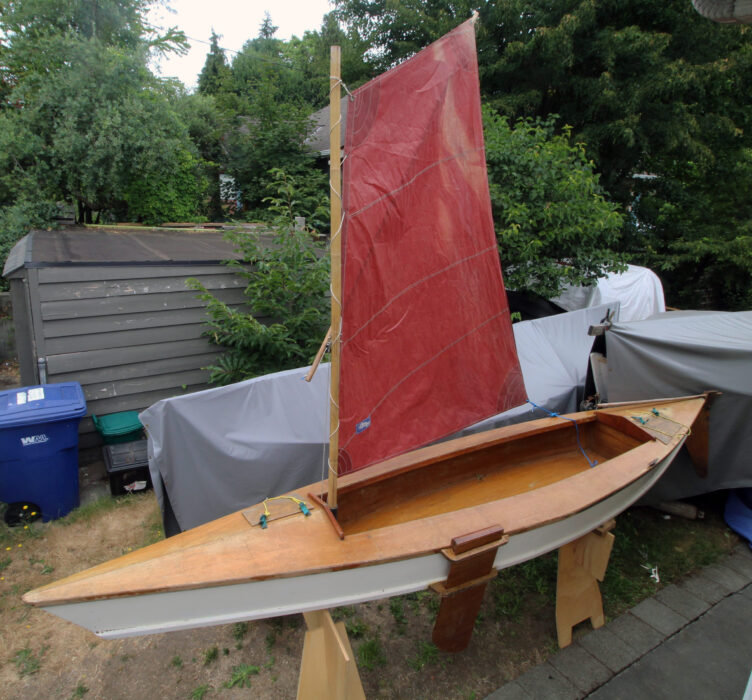
I put the pirogue in the back yard in the only spot left for another boat. Under the gray tarps are my gunning dory and Caledonia Yawl.
The boat has been in the back yard for almost a month now and the more times I looked at, sat in it, and raised its mast and spritsail, the more callous my plan felt. It didn’t seem right to use the boat only to get rid of it as soon as I no longer needed it. Phil Bolger had put his best efforts into the design, Dan had put his into its construction, and I felt I owed it to them to put mine into its restoration.
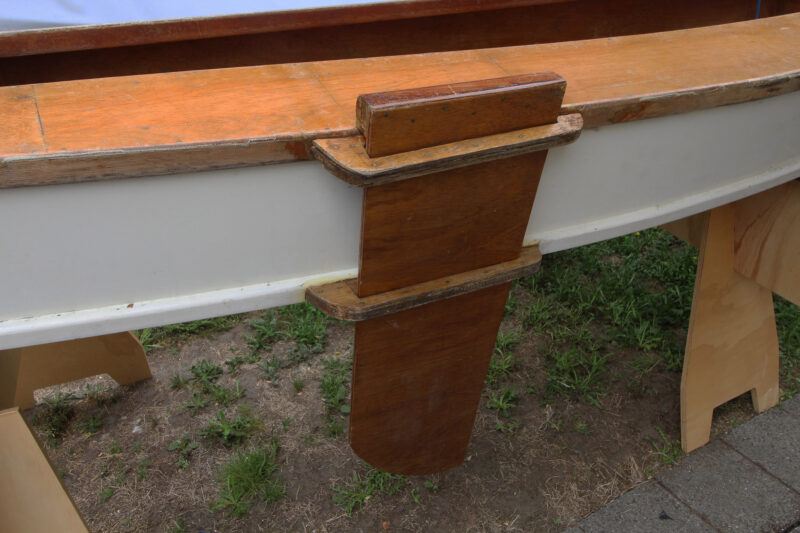
The plywood fittings for the leeboard haven’t held up well with age. I’ll likely remove them and build a trunk inboard.
I set the pirogue on sawhorses where I could better see what work needed to be done. The plywood brackets that would hold the leeboard were delaminating and I could replace them or, I thought, do without them, as other pirogue builders had done, and install an off-center daggerboard trunk under the side deck. The rudder had been designed with a yoke and tiller ropes, a system I’ve tried with other boats and have mixed feelings about. Dan preferred a tiller and had equipped the rudder with one made of a short length of bamboo. I imagined a Norwegian tiller like the one on my Caledonia Yawl would be a good match for the boat.
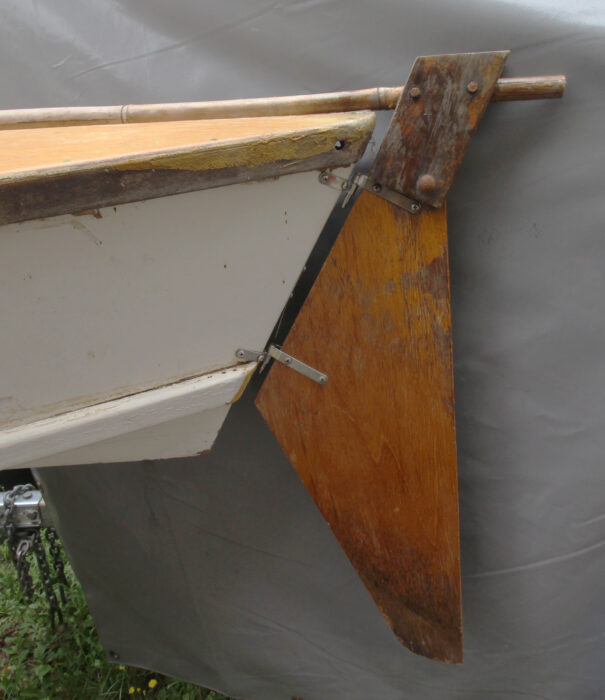
I plan to replace Dan’s bamboo tiller with a Norwegian tiller and I’ll convert the rudder blade from fixed to pivoting for easier launching and landing.
Having my thoughts drift to the work I wanted to do on the pirogue brought me back to something I’d enjoyed every time I built a new boat for myself: an engaging and active state of mind given over to problem-solving and visualizing in three dimensions.
After a day’s rain had leaked through the tarp I’d put over the pirogue, I flipped the boat upside down to keep it from gathering water again. The next sunny day, seeing the roughed-up paint on the hull, I felt compelled to bring the random-orbit sander out of the basement shop and start sanding. I never used to like that work much. After building a boat, sanding was a barrier to getting afloat, and there were far too many times that it had to be done between bare wood and topcoat. But with the pirogue, I might need to sand only once, and I could easily do that without my patience wearing thin. My left hand trailed the sander held in my right hand, feeling the irregularities on the paint’s surface lose their edges with each pass. My fingertips could sense the progress that my eyes could not. The dust from the sander turned my hands a white like the skin of a Japanese Butoh dancer, ghostly in rice powder.
The outwales were mottled black and pewter-gray where the varnish had worn away, and a jaundice yellow where it had not. A paint scraper couldn’t get through the discolored wood fast enough, so I took a palm plane to it. A few strokes uncovered the honey-colored Douglas fir, still redolent with its warm lemony fragrance after being hidden for almost three decades. On the starboard side, the forward section of the gunwale had a particularly tight grain, with rings so fine I needed a magnifying lens to count them. In the 1 ½″-wide outwale there were 56 rings, many almost invisibly thin. I looked forward to having the venerable wood finished bright again.
When I brought the pirogue home, I had intended to use it only for the review and then give it away. I hadn’t anticipated that having to do some work on it would lead to the reawakening of the senses and the stirring of imagination that had drawn me into boatbuilding in the late ’70s. It has been three years since I’ve had a boatbuilding project, and while I enjoy using the boats I have, I can fully appreciate them only when I get them afloat. A boat that I can work on at home is one that can pleasantly occupy my thoughts and my time every day. I’ll get much more from the pirogue than I put into it. And when it comes time to part with it, I’ll be able to take as much pride in the pirogue as Phil Bolger did in designing it and Dan did in building it. The boat deserves no less.![]()
The Pirogue at its beginning
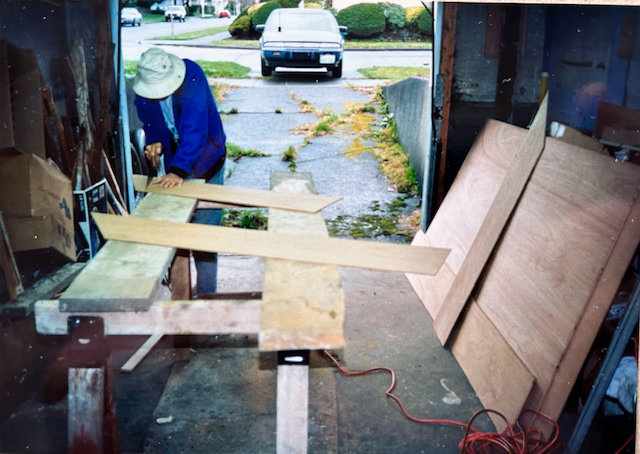 Old photographs courtesy of Dan
Old photographs courtesy of DanIn the spring of 1995, the pirogue came together in the one-car garage of Dan’s bungalow home, located north of downtown Seattle. His friend and co-builder David, here in his Tilley Endurable hat, is working on the boat’s side panels.
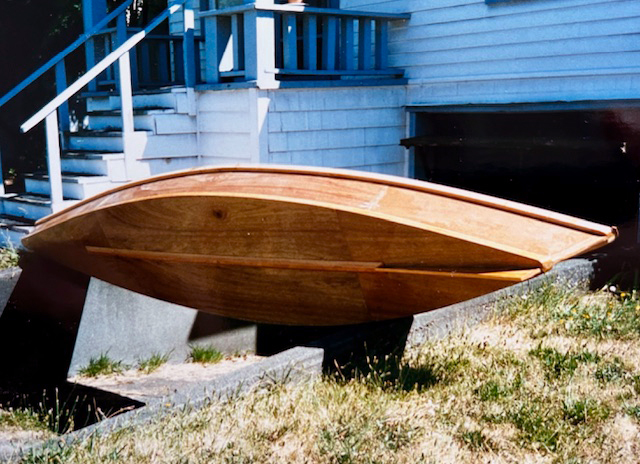
Brought out of the garage, the finished hull awaits outfitting for sailing.
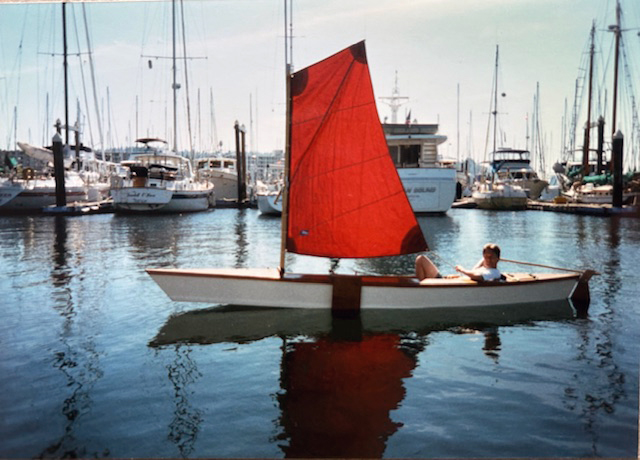
In 1997, Dan sailed the pirogue in light air in Seattle’s Shilshole Bay Marina. He had the tanbark sail made locally by Rush Sails, a small company no longer in business.

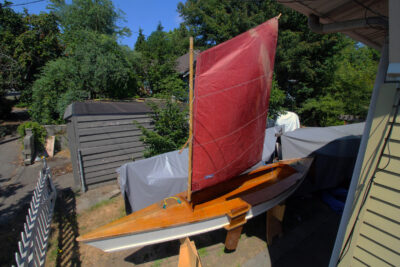
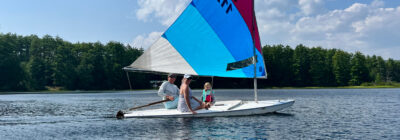
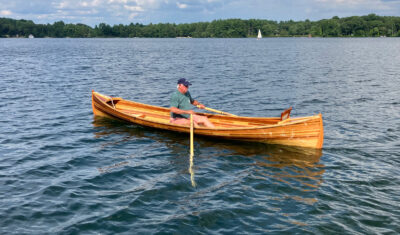
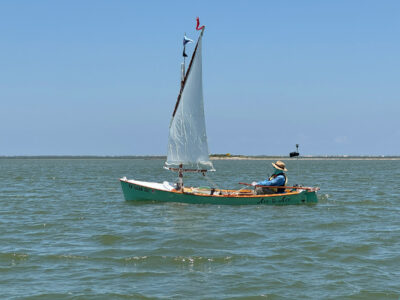
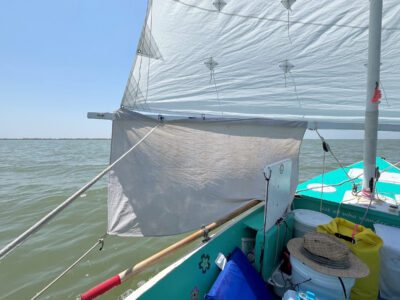
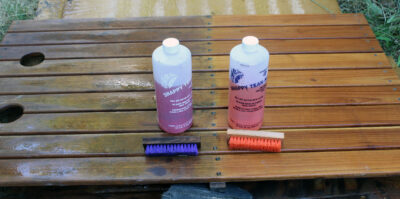
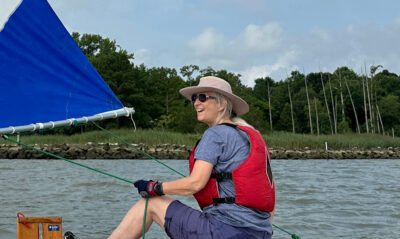
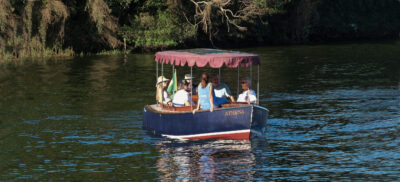
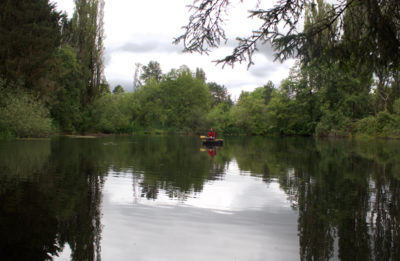

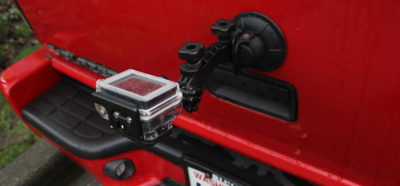

The paddle board I built in 2020 got water in it due to a worn spot at the stem and sitting out in the rain for three years, which made the plywood punky in a small area. As I was cutting out the damaged ply, replacing it and sealing it up again with fiberglass and epoxy, I thought, “wow, I really miss doing this stuff!”
A few days later, my wife asked me what I was going to do that day and I said, I didn’t have anything to do. She asked what did I want to do and I said, “build a boat.” She gave me a sideways glance and a smirk. Hmmmm, maybe this fall…..
There is a particularly nice feeling of satisfaction and accomplishment in bringing a boat, or any other object, back to usable life. This is a different sort of warmth that is similar to, but uniquely its own, the creation of an entirely new object. Perhaps it’s the knowledge that one is resurrecting the original builder’s dream/accomplishment. The restoration acting as the means for helping another person live just a bit longer.
Lovely Boat, I understand the feeling. I have never been able to “leave well enough alone” when it comes to boats, new or old. Something like the Pirogue, in my hands, would be going through the same treatment as yours.
As I have not yet come close to mastering my duckpunt, even after two years of trying, I may look to the pirogue for inspiration for a rudder and off-set dagger board.
That looks like a fun boat, roomy, and simple to maintain and repair. We are glad you had room for it.
And somehow another Tilley appeared. Maybe we need folks to send in pictures of their Tilley for a special issue.
Does the boat have a name?
No name came with the boat and I haven’t come up with one yet.
Since your review, I’ve seen four or five of the Tilley Airflows.
No name came with the boat and I haven’t come up with one yet.
I’ve seen four or five of the Tilley hats in the area here.